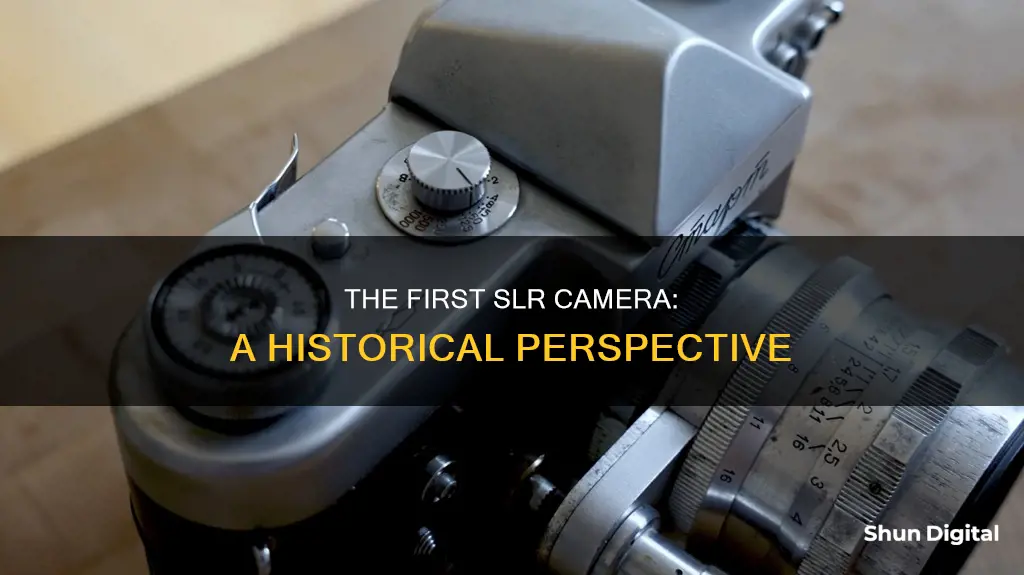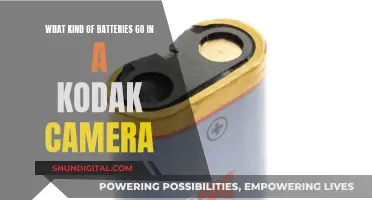
The single-lens reflex camera (SLR) is a camera that uses a mirror and prism system to allow the photographer to see through the lens and view exactly what will be captured. The first patent for an SLR camera was granted to Thomas Sutton in 1861, and the first cameras were produced in 1884. However, the first 35mm SLR available to the mass market was the Leica PLOOT reflex housing, which debuted in 1935. The first integrated 35mm SLR to enter the market was the Kine Exakta, produced in Germany in 1936. The Japanese adopted and further developed the SLR, with companies such as Asahi, Canon, Nikon, and Yashica introducing their first SLRs in the 1950s. Today, SLRs remain popular among high-end and professional photographers due to their customizability, low shutter lag, and superior image quality compared to LCD screens.
| Characteristics | Values |
|---|---|
| First patent for an SLR camera granted to | Thomas Sutton |
| First production SLR with a brand name | Calvin Rae Smith's Monocular Duplex |
| First 35mm SLR available to the mass market | Leica's PLOOT reflex housing |
| First integrated 35mm SLR to enter the market | K. Nüchterlein's Kine Exakta |
| First eye-level SLR viewfinder patented in Hungary | Jenő Dulovits |
| First 35mm camera with one | Jenő Dulovits's Duflex |
| First commercially produced SLR that employed a roof pentaprism | Italian Rectaflex A.1000 |
| First Japanese pentaprism SLR | 1955 Miranda T |
| First 35mm SLR with a reliable instant return mirror | Asahiflex IIB |
| First 35mm SLR with a built-in light meter | VEB Zeiss Ikon (Dresden) Contax E |
| First 35mm SLR with leaf shutter | Zeiss Ikon Contaflex I |
| First 35mm SLR with built-in electronic flash | Sedic Hanimex Reflex Flash 35 |
| First 35mm SLR with built-in autofocus | Pentax ME F |
| First 35mm SLR with built-in motordriven film auto-loading | Konica FS-1 |
What You'll Learn
- The first 35mm SLR camera was the Kine Exakta, developed by Ihagee in 1936
- The first 35mm SLR camera with an instant-return mirror was the Duflex, developed by Jenő Dulovits in 1948
- The first 35mm SLR camera with a pentaprism viewfinder was the Rectaflex, developed by Telemaco Corsi in 1947
- The first Japanese 35mm SLR camera was the Asahiflex, developed by Asahi in 1952
- The first 35mm SLR camera with a built-in light meter was the Contax E, developed by VEB Zeiss Ikon in 1951

The first 35mm SLR camera was the Kine Exakta, developed by Ihagee in 1936
The Kine Exakta was the first integrated 35mm SLR to enter the market. It featured a waist-level finder, a rapid film wind thumb lever, and a focal plane shutter with speeds ranging from 1/12 to 1/1000 of a second. The camera was well-integrated and had excellent interchangeable lenses and a good accessory system.
The development of the Kine Exakta was a significant milestone in the history of photography. It played a crucial role in making the 35mm SLR format popular and established Ihagee as a leading camera manufacturer. The success of the Kine Exakta led to the production of additional Exakta models, both during and after World War II.
The Kine Exakta was a groundbreaking camera that paved the way for future innovations in photography. It set a standard for SLR cameras and influenced the designs of subsequent models. Its impact extended beyond the photography industry, as it also contributed to the development of other optical devices and imaging technologies.
Action Camera Batteries: How Long Do They Really Last?
You may want to see also

The first 35mm SLR camera with an instant-return mirror was the Duflex, developed by Jenő Dulovits in 1948
Jenő Dulovits, a Hungarian teacher, photographer and inventor, began working on the Duflex in the 1930s, driven by a desire for a more professional camera that could overcome the limitations of the cameras available on the market at the time. He created the first prototypes of the Duflex out of cardboard in 1939, showcasing his passion for innovation and his dedication to improving the photographic experience.
The Duflex was first patented in 1942 and licensed to Gamma Optikail Művek of Budapest for production. However, due to the war, the first samples of the Duflex were not produced until 1948, with the bulk of the production occurring in 1949. The camera incorporated a pentaprism, which allowed for eye-level viewing and provided a non-reversed, upright image. This feature, combined with the instant-return mirror, transformed the SLR camera market and set a new standard for future designs.
The Duflex was a groundbreaking camera that played a pivotal role in the evolution of photography. It empowered photographers by offering them a tool that provided an accurate and reliable view of the scene they were capturing. The impact of the Duflex extended beyond its time, influencing future camera designs and shaping the way photographers interact with their equipment.
Olympus Cameras: Crafted in the Heart of Japan
You may want to see also

The first 35mm SLR camera with a pentaprism viewfinder was the Rectaflex, developed by Telemaco Corsi in 1947
The Rectaflex was the first 35mm SLR camera with a pentaprism viewfinder. It was developed by the Roman lawyer and industrialist Telemaco Corsi and first presented at the Milano Fiera in April 1947. The prototype was a wooden mock-up with a mirror eye-level finder, which gave a left-to-right inverted image. This was a major drawback as the image was upside down for vertical pictures.
The pre-series model, called the Rectaflex Standard 947, was presented at the 1948 Milano show. This model had a fully working pentaprism as well as a focal plane shutter from 1s to 1/1000, synchronised at 1/25. The Rectaflex was produced from 1948 to 1958 and was the only Italian single-lens reflex camera ever built.
The Rectaflex was the world's first series-produced Pentaprism single-lens reflex camera. It was the first SLR camera to be equipped with a pentaprism, with series production starting in September 1948. It hit the market one year before the Contax S, which was presented in 1949. The Rectaflex was in production and on sale in the northern autumn of 1948.
The Rectaflex had interchangeable lenses and a wide diameter bayonet mount. The chief designer was Telemaco Corsi. The first production model was the Rectaflex series A 1000 (serial number 1000 to 2150), which was quite similar to the pre-series model. The Rectaflex series B 2000 (serial number 2150 to 2999) added a split image device in the focusing screen and had no film cutter.
Activating Patrol Mode on Hikvision Cameras: A Step-by-Step Guide
You may want to see also

The first Japanese 35mm SLR camera was the Asahiflex, developed by Asahi in 1952
The first Japanese 35mm SLR camera was the Asahiflex, developed by Asahi Optical Corporation (later known as Pentax) in 1952. This camera played a significant role in the history of photography and the evolution of the SLR camera.
Prior to the Asahiflex, Asahi had been producing lenses for the Japanese camera industry since 1929, supplying companies that would eventually become Minolta and Konica. However, the Asahiflex marked Asahi's first foray into camera manufacturing.
The Asahiflex was designed by Nobuyuki Yoshida and Ryohei Suzuki, who chose to model it after the Praktiflex, a 1939 German design. The Asahiflex featured a non-interchangeable waist-level viewfinder and a direct optical viewfinder for eye-level use. It did not have a returning mirror, which meant that the mirror had to be manually repositioned to redirect light to the viewfinder for composing and focusing.
The Asahiflex was followed by the Asahiflex Ia in 1953, which introduced some modifications, including normalized shutter speed numbers. The Asahiflex series culminated in the Asahiflex IIb, released in 1954, which was the first SLR with an instant-return mirror. This innovation addressed the issue of mirror blackout, a common problem in earlier SLR designs, and significantly improved usability.
In 1957, the Asahiflex series was discontinued in favor of the new Asahi Pentax, marking a shift in Pentax's approach to SLR design. The Asahiflex's legacy lies in its role as a pioneer in Japanese SLR camera development, paving the way for future innovations in the industry.
Swann 700TVL Camera Battery Location Guide
You may want to see also

The first 35mm SLR camera with a built-in light meter was the Contax E, developed by VEB Zeiss Ikon in 1951
The Contax E was a significant milestone in the history of photography and the development of the SLR camera. The SLR camera, or single-lens reflex camera, is characterised by its use of a reflex mirror and prism system, which allows the photographer to view the image exactly as it will be captured through the lens. This was a notable improvement on twin-lens reflex and rangefinder cameras, which produced images that were significantly different from what the photographer viewed through the viewfinder.
The Contax E was developed by VEB Zeiss Ikon, a company that emerged after World War II when Zeiss Ikon of Dresden began production in East Germany. The original Zeiss Ikon company was split, with a new Zeiss Ikon AG formed in the US zone, and the original company gradually disappearing and being replaced by the name Pentacon.
VEB Zeiss Ikon was responsible for the Contax S, the first 35mm SLR to employ a roof pentaprism, which was introduced in 1949. This camera also introduced the M42 lens mount, which became an industry standard. The Contax E was a subsequent model, offering the first built-in light meter in a 35mm SLR.
The Contax series of cameras has a long history, with the name originating from a 1932 Zeiss Ikon camera model. Over time, the brand changed hands, with production ceasing in 2005 when Kyocera, which had acquired Yashica in 1983 and continued manufacturing products under the Yashica and Contax brands, discontinued all photographic equipment manufacturing.
RAW Files: Camera Limitations and Workarounds
You may want to see also
Frequently asked questions
The first 35mm SLR camera was the "Kine Exakta", developed by the company Ihagee in Dresden, Germany, in 1936.
The first 35mm SLR camera with a built-in flash was the "Hanimex Reflex Flash 35", developed by the Japanese company Sedic in the 1970s.
The first 35mm SLR camera with a zoom lens was the "Nikkorex Zoom 35", developed by the Japanese company Nippon Kogaku in 1960.
The first 35mm SLR camera with autofocus was the "Pentax ME F", developed by the Japanese company Pentax in 1981.
The first 35mm SLR camera with a digital sensor was the "Kodak DCS", developed by the American company Kodak in the 1990s.







